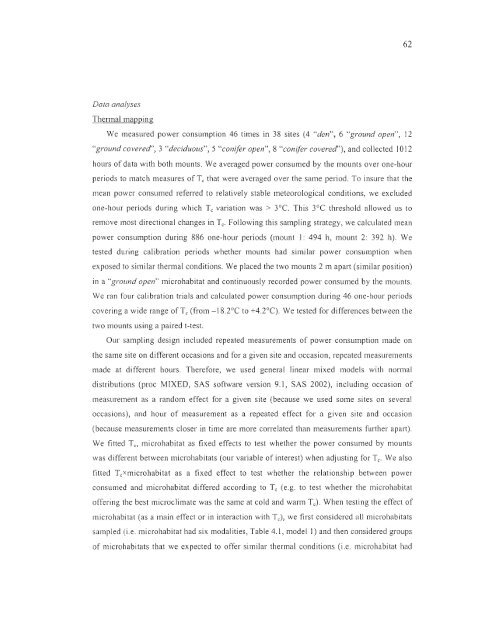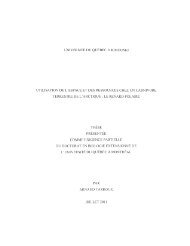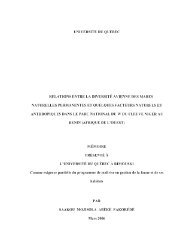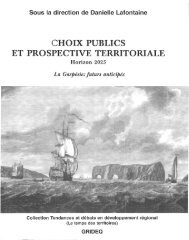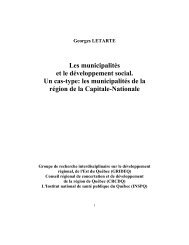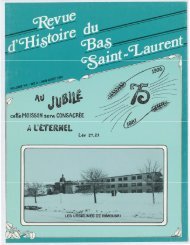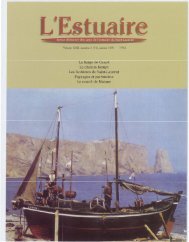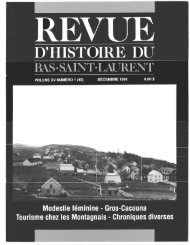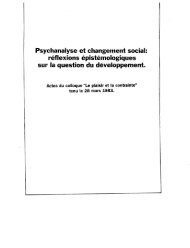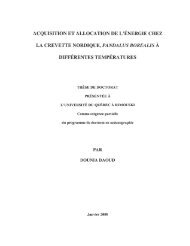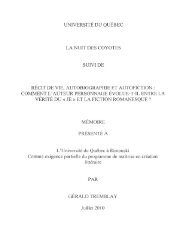influence du climat et de la prédation sur l'utilisation de l'habitat et la ...
influence du climat et de la prédation sur l'utilisation de l'habitat et la ...
influence du climat et de la prédation sur l'utilisation de l'habitat et la ...
You also want an ePaper? Increase the reach of your titles
YUMPU automatically turns print PDFs into web optimized ePapers that Google loves.
62<br />
Data analyses<br />
Thermal mapping<br />
We mea<strong>sur</strong>ed power consumption 46 times in 38 sites (4 "<strong>de</strong>n", 6 "ground open", 12<br />
"ground covered" , 3 "<strong>de</strong>ci<strong>du</strong>ous", 5 "conifer open", 8 "conifer covered"), and col!ected 1012<br />
hours of data with both mounts. We averaged power consumed by the mounts over one-hour<br />
periods to match mea<strong>sur</strong>es of Tc that were averaged over the same period. To in<strong>sur</strong>e that the<br />
mean power consumed referred to re<strong>la</strong>tively stable m<strong>et</strong>eorological conditions, we exclu<strong>de</strong>d<br />
one-ho ur periods <strong>du</strong>ring which Tc variation was > 3°C. This 3°C threshold allowed us to<br />
remove most directional changes in Tc. Following this sampling strategy, we calcu<strong>la</strong>ted me an<br />
power consumption <strong>du</strong>ring 886 one-hour periods (mount 1: 494 h, mount 2: 392 h) . We<br />
tested <strong>du</strong>ring calibration periods wh<strong>et</strong>her mounts had simi<strong>la</strong>r power consumption when<br />
exposed to simi<strong>la</strong>r thermal conditions. We p<strong>la</strong>ced the two mounts 2 m apart (simi<strong>la</strong>r position)<br />
in a "ground open" microhabitat and continuously recor<strong>de</strong>d power consumed by the mounts.<br />
We ran four calibration trials and calcu<strong>la</strong>ted power consumption <strong>du</strong>ring 46 one-hour periods<br />
covering a wi<strong>de</strong> range of Tc (from -I8.2°C to +4.2°C). We tested for differences b<strong>et</strong>ween the<br />
two mounts using a paired t-test.<br />
Our sampling <strong>de</strong>sign inclu<strong>de</strong>d repeated mea<strong>sur</strong>ements of power consumption ma<strong>de</strong> on<br />
the same site on different occasions and for a given site and occasion, repeated mea<strong>sur</strong>ements<br />
ma<strong>de</strong> at different hours. Therefore, we used general linear mixed mo<strong>de</strong>ls with normal<br />
distributions (proc MIXED, SAS software version 9.1, SAS 2002), including occasion of<br />
mea<strong>sur</strong>ement as a random effect for a given site (because we used some sites on several<br />
occasions), and hour of mea<strong>sur</strong>ement as a repeated effect for a given site and occasion<br />
(bec au se mea<strong>sur</strong>ements closer in time are more corre<strong>la</strong>ted th an mea<strong>sur</strong>ements further apart).<br />
We fitted Tc, microhabitat as fixed effects to test wh<strong>et</strong>her the power consumed by mounts<br />
was different b<strong>et</strong>ween microhabitats (our variable of interest) when adjusting for Tc. We also<br />
fitted Tcx microhabitat as a fixed effect to test wh<strong>et</strong>her the re<strong>la</strong>tionship b<strong>et</strong>ween power<br />
consumed and microhabitat differed according to Tc (e.g. to test wh<strong>et</strong>her the microhabitat<br />
offering the best micro<strong>climat</strong>e was the same at cold and wann Tc). When testing the effect of<br />
microhabitat (as a main effect or in interaction with Tc), we first consi<strong>de</strong>red ail microhabitats<br />
sampled (i.e. microhabitat had six modalities, Table 4.1, mo<strong>de</strong>l 1) and then consi<strong>de</strong>red groups<br />
of microhabitats that we expected to offer simi<strong>la</strong>r thermal conditions (i.e. microhabitat had


